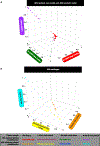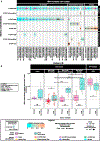A Distinct DNA Methylation Shift in a Subset of Glioma CpG Island Methylator Phenotypes during Tumor Recurrence
- PMID: 29642018
- PMCID: PMC8859991
- DOI: 10.1016/j.celrep.2018.03.107
A Distinct DNA Methylation Shift in a Subset of Glioma CpG Island Methylator Phenotypes during Tumor Recurrence
Abstract
Glioma diagnosis is based on histomorphology and grading; however, such classification does not have predictive clinical outcome after glioblastomas have developed. To date, no bona fide biomarkers that significantly translate into a survival benefit to glioblastoma patients have been identified. We previously reported that the IDH mutant G-CIMP-high subtype would be a predecessor to the G-CIMP-low subtype. Here, we performed a comprehensive DNA methylation longitudinal analysis of diffuse gliomas from 77 patients (200 tumors) to enlighten the epigenome-based malignant transformation of initially lower-grade gliomas. Intra-subtype heterogeneity among G-CIMP-high primary tumors allowed us to identify predictive biomarkers for assessing the risk of malignant recurrence at early stages of disease. G-CIMP-low recurrence appeared in 9.5% of all gliomas, and these resembled IDH-wild-type primary glioblastoma. G-CIMP-low recurrence can be characterized by distinct epigenetic changes at candidate functional tissue enhancers with AP-1/SOX binding elements, mesenchymal stem cell-like epigenomic phenotype, and genomic instability. Molecular abnormalities of longitudinal G-CIMP offer possibilities to defy glioblastoma progression.
Keywords: DNA methylation; G-CIMP-high; G-CIMP-low; IDH mutation; intra-subtype heterogeneity; longitudinal gliomas; malignant transformation and recurrence; predictive biomarkers; stem cell-like glioblastoma.
Copyright © 2018 The Author(s). Published by Elsevier Inc. All rights reserved.
Conflict of interest statement
DECLARATION OF INTERESTS
Peter W. Laird is a member of the Scientific Advisory Board of AnchorDx. All other authors declare no competing interests.
Figures





Similar articles
-
Molecular subtypes of glioma identified by genome-wide methylation profiling.Genes Chromosomes Cancer. 2013 Jul;52(7):665-74. doi: 10.1002/gcc.22062. Epub 2013 Apr 30. Genes Chromosomes Cancer. 2013. PMID: 23629961
-
IDH1 mutation is sufficient to establish the glioma hypermethylator phenotype.Nature. 2012 Feb 15;483(7390):479-83. doi: 10.1038/nature10866. Nature. 2012. PMID: 22343889 Free PMC article.
-
CRISPR Editing of Mutant IDH1 R132H Induces a CpG Methylation-Low State in Patient-Derived Glioma Models of G-CIMP.Mol Cancer Res. 2019 Oct;17(10):2042-2050. doi: 10.1158/1541-7786.MCR-19-0309. Epub 2019 Jul 10. Mol Cancer Res. 2019. PMID: 31292202 Free PMC article.
-
Glioma CpG island methylator phenotype (G-CIMP): biological and clinical implications.Neuro Oncol. 2018 Apr 9;20(5):608-620. doi: 10.1093/neuonc/nox183. Neuro Oncol. 2018. PMID: 29036500 Free PMC article. Review.
-
Treatment of anaplastic glioma.Cancer Treat Res. 2015;163:89-101. doi: 10.1007/978-3-319-12048-5_6. Cancer Treat Res. 2015. PMID: 25468227 Review.
Cited by
-
Potential Epigenetic-Based Therapeutic Targets for Glioma.Front Mol Neurosci. 2018 Nov 15;11:408. doi: 10.3389/fnmol.2018.00408. eCollection 2018. Front Mol Neurosci. 2018. PMID: 30498431 Free PMC article. Review.
-
Comprehensive omics analyses profile genesets related with tumor heterogeneity of multifocal glioblastomas and reveal LIF/CCL2 as biomarkers for mesenchymal subtype.Theranostics. 2022 Jan 1;12(1):459-473. doi: 10.7150/thno.65739. eCollection 2022. Theranostics. 2022. PMID: 34987659 Free PMC article.
-
ADAR2 Protein Is Associated with Overall Survival in GBM Patients and Its Decrease Triggers the Anchorage-Independent Cell Growth Signature.Biomolecules. 2022 Aug 19;12(8):1142. doi: 10.3390/biom12081142. Biomolecules. 2022. PMID: 36009036 Free PMC article.
-
Repeat surgery of recurrent glioma for molecularly informed treatment in the age of precision oncology: A risk-benefit analysis.J Neurooncol. 2024 Apr;167(2):245-255. doi: 10.1007/s11060-024-04595-5. Epub 2024 Feb 9. J Neurooncol. 2024. PMID: 38334907 Free PMC article.
-
Expression and regulatory roles of lncRNAs in G-CIMP-low vs G-CIMP-high Glioma: an in-silico analysis.J Transl Med. 2021 Apr 29;19(1):182. doi: 10.1186/s12967-021-02844-z. J Transl Med. 2021. PMID: 33926464 Free PMC article.
References
-
- Baysan M, Woolard K, Cam MC, Zhang W, Song H, Kotliarova S, Balamatsias D, Linkous A, Ahn S, Walling J, et al. (2017). Detailed longitudinal sampling of glioma stem cells in situ reveals Chr7 gain and Chr10 loss as repeated events in primary tumor formation and recurrence. Int. J. Cancer 141, 2002–2013. - PubMed
-
- Benjamini Y, and Hochberg Y. (1995). Controlling the False Discovery Rate - a Practical and Powerful Approach to Multiple Testing. J. Roy. Stat. Soc. B. Met 57, 289–300.
MeSH terms
Substances
Grants and funding
LinkOut - more resources
Full Text Sources
Other Literature Sources
Medical
Miscellaneous

